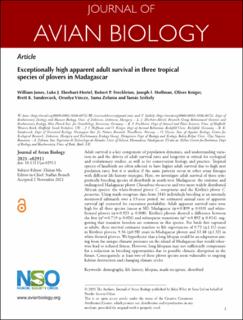| dc.description.abstract | Adult survival is a key component of population dynamics, and understanding variation in and the drivers of adult survival rates and longevity is critical for ecological and evolutionary studies, as well as for conservation biology and practice. Tropical species of landbirds are often selected to have higher adult survival due to high nest predation rates, but it is unclear if the same patterns occur in other avian lineages with different life history strategies. Here, we investigate adult survival of three sympatrically breeding species of shorebirds in south-west Madagascar: the endemic and endangered Madagascar plover Charadrius thoracicus and two more widely distributed African species: the white-fronted plover C. marginatus and the Kittlitz’s plover C. pecuarius. Using mark–recapture data from 1843 individuals breeding at an intensely monitored saltmarsh over a 13-year period, we estimated annual rates of apparent survival (φ) corrected for encounter probability. Adult apparent survival rates were high for all three species (mean ± SE): Madagascar (φ = 0.899 ± 0.010) and whitefronted plovers (φ = 0.923 ± 0.008). Kittlitz’s plovers showed a difference between the first (φ1 = 0.719 ± 0.026) and subsequent transitions (φ2+ = 0.892 ± 0.014), suggesting that transient breeders are common in this species. For birds first captured as adults, these survival estimates translate to life expectancies of 9.72 (±1.11) years in Kittlitz’s plovers, 9.36 (±0.98) years in Madagascar plovers and 12.48 (±1.32) in white-fronted plovers. We hypothesise that a long lifespan could be an adaptation arising from the unique climatic pressures on the island of Madagascar that would otherwise lead to reduced fitness. However, long lifespans may not sufficiently compensate for a reduction in breeding opportunities due to possible climatic disruption in the future. Consequently, at least two of these plover species seem vulnerable to ongoing habitat destruction and changing climate cycles. demography, life history, lifespan, mark–recapture, shorebird | en_US |

